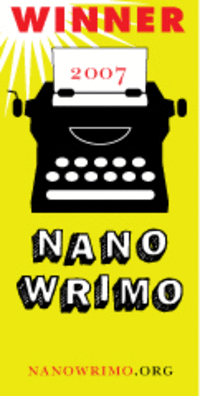I’ve been aware of NaNoWriMo for a number of years, but every year by the time November hit, all I’d be thinking of after the time-change would be surviving the tsunami of deadlines that seemed to arrive at this time of year, the pre-Christmas disruptions, and the prospect of not seeing more than a couple of hours of sunlight a week until February. Plus, years of being a part time writer has left me with a sprint and stall pattern wherein I grew accustomed to using the intervals when I did not have the time to write to incubate the next section. It made my working time efficient, but it meant I write in wind-sprints. I had no idea whether I could write 50 000 words belonging to a single project in a month.
This November I’m between jobs, and I decided that if I were ever to ‘do NaNo’ for the first time, I should do it now. I’d also just finished a novel, so had to start another – which was another obstacle, as the first quarter of a novel can take a long time growing, though the last quarter is usually written at speed. I decided to attempt a sequel to Cavalcade. I’d always known that story was longer than the one I told in the one book. I had some of the characters, and I knew the setting, and I sort of knew where I would be going. I rumbled happily along for a few days, to about 6,000 words, then hit a point where I had to do significant work on world, characters AND plot and realized that this was not sustainable at an average of 1,667 wpd.
So I switched projects and restarted with a sequel to the novel I’d just finished, which was meant to be the first of a trilogy. I had continuity through one group of characters and the fix I’d left them in at the end of the first book. A session with a notebook in my favourite cafe (my favourite way of plotting) gave me an outline that swept me along to 24,000 words, at which point I needed to develop up another major thread, which was going to involve new characters and new culture, and I was out of outline. By now it was past mid-November. I had 5 days out, traveling across the country on another project I’m involved in. By the time I came back, I was about 10 000 words behind, and I had given up.
But that cold start would still be waiting for me after November, and it wouldn’t feel any better then. Worse, because I would not have made my declared target. So Sunday 25th, I sat down and restarted at around 27,000 words, determined that I was not going to bed that night until I had built some momentum, even if I were literally constructing world, character, plot and situation line by line, a process that usually takes weeks. For four days I wrote 5000 words a day, jumping from new to established plot-lines and back and praying I could avoid the convergence of those plot-lines because I knew it was going to take me several shots to get it right. I hit target over seven hours before deadline on the last day, with a final word-count of 50,790 words, which is about half the novel. It’s raw first draft, but if half what I’ve laid in place survives to the true first draft, I will be well pleased with the results of the experiment.
Writing words is not the challenge: I’ve had years to develop fluency in the language, and I write quickly once the material has taken shape. I can hold complex structures in my head and track details. The rate limiting step is coming up with the plot, the ideas that – taking language from my days fitting curves to data – aren’t first-order solutions, but are third and fourth order solutions. They’re the events that happen because they’re the ones that fit my particular characters in my particular situation; the characters are dealing with those problems, making those particular choices, because given who they are and where they come from, they couldn’t be doing anything else. And it takes me time to get there. It was disconcerting writing without giving myself the time. I’m not sure whether what I’ve got is first order, superficial and clichéd, or whether putting my creative subconscious under pressure forced something better out of it. But doing this has made the distinction between the actual getting words down on the screen and the doing the thinking behind those words clearer than ever.
Would I do it again? Quite likely, and I’d like to see what effect is of a concerted pre-planning step, how much I can work out in advance versus how much I need to work out as I write. Maybe I could persuade some of the other 100 000 slightly mad people who participated this year to make October 2008 NaNoPlaMo – National Novel Planning Month …?
